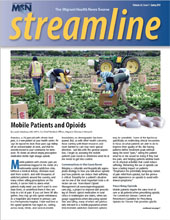
Francisco, a 26-year-old with chronic backpain, is a new patient at your health center. Hesays he injured his back three years ago fallingoff an orchard ladder at work, and that herecently moved to your community for farmwork.He shows an almost empty prescription medication bottle: high dosage opioids.
Mobile patients with chronic pain are sometimes trapped in the midst of a nationwide opioid addiction crisis. Without a medical history, clinicians must start from scratch. And with thousands of addicted patients around the country, and many others selling prescriptions on the streets, it can be hard to assess what patients really need: you don’t want to overdose them, or undertreat them if they are truly in a lot of pain. If you cut them off altogether, they may go into opioid withdrawal. As a hospitalist also trained in primary care in a Pennsylvania hospital, I have watched as the opioid epidemic has raged on, cutting across racial, ethnic, and socio-economic boundaries; no demographic has been spared. But, as with other health concerns, those starting with fewer resources and more barriers to care may need special attention. Just like with the general population, I begin by assessing the mobile patient’s pain needs to determine what he or she needs to get into control.
Conversations in the Exam Room
Bringing a culturally and linguistically appropriate strategy to how you talk about opioids and how patients can reduce their suffering is critical. Empathy for a patient’s situation can be one of the most important tools a clinician can use. Team-Based Opioid Management (at www.improvingopioidcare.org), a project to improve safe prescribing of chronic opioid medication in rural clinics in Washington and Idaho, offers language suggestions when discussing opioid risks and safety, many of which are particularly relevant to a mobile population where time-intensive addiction treatment options may be unrealistic. Some of the tips focus specifically on redirecting clinical encounters to focus on what patients are able to do to improve their quality of life, like having patients define treatment goals without using the word “pain,” asking the patient what he or she would be doing if they had less pain, and helping patients address barriers to physical activities that could reduce suffering. Reframing the use of opioids can have a lasting impact on patients: “Emphasize the potentially temporary nature of pain relief from opioids, but the permanent dependence on opioids to avoid withdrawal symptoms.”
Prescribing Opioids
Mobile patients require the same level of care as all patients when prescribing opioids. The Centers for Disease Control and Prevention’s Guideline for Prescribing Opioids for Chronic Pain provides specific recommendations. The guideline addresses:
- when to initiate or continue opioids for chronic pain;
- opioid selection, dosage, duration, follow-up, and discontinuation;
- assessing risk and addressing harms of opioid use.
The Guideline is downloadable online at https://www.cdc.gov/drugoverdose/prescribing/guideline.html.
Avoiding Repeat Prescriptions Across County Lines
Some regions have implemented Prescription Drug Monitoring Programs (PDMPs). I use Pennsylvania’s PDMP to assure I make clinically appropriate decisions. Pennsylvania’s system was recently expanded to include Maryland and Delaware prescriptions, which is particularly relevant for mobile patients who may have last seen a doctor in another state. Some evidence indicates that the use of PDMPs helps reduce “doctor shopping.” Each state’s PDMP may differ, but use of the PDMP is important for mobile patients. According to the Prescription Drug Monitoring Program Training and Technical Assistance Center, 49 states, the District of Columbia, and Guam all have operational PDMPs. Their maps, state profiles, and FAQs can assist clinicians further in understanding how the PDMP works in their states: http://www.pdmpassist.org.
Despite the use of such drug monitoring programs, there is very little information that passes to the primary care physician if their patient has recently overdosed. There are no mandates for EMS or police to provide a report to the primary doctor on the use of Narcan to reverse an overdose in the field or on the way to the hospital. The ER physician may get a verbal or written report, but often patients are revived outside a medical facility, and refuse to come to the ER after Narcan had been given. The information is then lost, and the primary care doctor may once again refill the narcotic medication.
The Other Opioid Crisis
A commission of The Lancet recently published their report on global use of opioids, which describes how just 0.03 percent of morphine-equivalent opioids distributed in the world each year go to low income countries. The commission concludes that the lack of global access to pain relief and palliative care is a global crisis of its own: “The fact that most patients, poor patients in particular— including many poor people in high income countries—are denied access to such an inexpensive and powerful intervention is a medical, public health, and moral failing.”
Encountering Addiction and Providing Treatment
Unfortunately, many patients with prescriptions for opioids may be addicted. Attempting to take into account the many challenges that opioid addiction may present in a patient’s life is difficult, and is why so many remain without sufficient support to beat addiction. Mobility brings more complications that a clinician should take into account. Being mobile and having in one’s possession a significant number of narcotic medications, even if legitimately obtained through a clinician, may look suspicious when being questioned by police or immigration officials, and put the mobile poor at some real or imagined legal risk. With mobile patients who may be away from family and other emotional support for months at a time, behavioral health may be another concern to fold into the patient encounter. Indeed, many of the barriers that affect mobile patient care in other realms — language, lack of sufficient health care coverage, irregular appointments at new health centers after every move — complicate care for opioid addiction as well. In managing opioid use disorder among mobile patients, clinicians in the exam room need to adjust their addiction strategies to take into account a patient with a mobile lifestyle, who may be unable to take part in outpatient programs or other counseling opportunities over time, as they may find themselves moving again before a program can make a lasting impact. Some successful strategies for addicted mobile patients include:
Health Network: MCN’s bridge case management assures timely and accurate records transfer for mobile patients: https://www.migrantclinician.org/services/network.html
SAMSHA’s Treatment Services Locator: The Substance Abuse and Mental Health Services Administration hosts three important search tools that allow clinicians to assure that a patient can continue treatment even if she or he has to move: https://www.findtreatment.samhsa.gov/
-
Buprenorphine Treatment PractitionerLocatorBuprenorphine Treatment PractitionerLocator
- Methadone Treatment Program Locator
- Behavioral Health Treatment Services Locator
The material presented in this portion of Streamline is supported by the Health Resources and Services Administration (HRSA) of the U.S. Department of Health and Human Services (HHS) under cooperative agreement number U30CS09742, Technical Assistance to Community and Migrant Health Centers and Homeless for $1,094,709.00 with 0% of the total NCA project financed with non-federal sources. This information or content and conclusions are those of the author and should not be construed as the official position or policy of, nor should any endorsements be inferred by HRSA, HHS or the U.S. Government.
Read this article in the Spring 2018 issue of Streamline here!
Sign up for our eNewsletter to receive bimonthly news from MCN, including announcements of the next Streamline.
